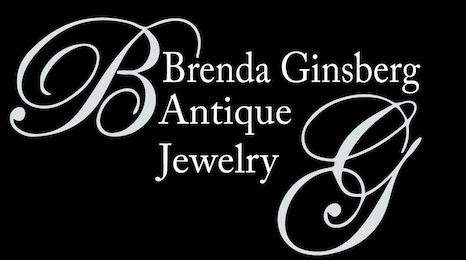Brenda Ginsberg Antique Jewelry
Louis WIESE cameo brooch pendant gold enamel agate Medusa Antique Unisex (7228)
Louis WIESE cameo brooch pendant gold enamel agate Medusa Antique Unisex (7228)
Regular price
$15,000.00 USD
Regular price
Sale price
$15,000.00 USD
Unit price
per
Couldn't load pickup availability
Antique brooch pendant. 18k gold, enamel, agate hardstone cameo. Made in France by Louis Wiese, circa 1890. Unisex - suitable to be worn by a man or a woman.
Measurements: Weight is 10.9 grams. Approximately 1 inch (2.5cm) in diameter.
Description :
Round brooch with a loop so that it can also be hung from a chain or ribbon. Generally round in shape with concentric rings: the outer ring of green enamel. Within, a concave ring of gold,with very fine gold beads (granulation) near the outside and a filigree, looped pattern within. This encloses a hardstone, agate cameo that appears to be from the Ancient Greek period. However, it was most probably made in the 19th century in the style of the Ancient Greeks (see below). The cameo is quite 3-dimentional - a tiny sculpture of a Grecian goddess.
Hinged pin in gold with a c-clasp and loop attachment.
Made by Louis Wiese, son of Jules Wiese and trained by his father, Louis took over the business after 1880. Known for their superb craftsmanship, they initially made jewelry for the top Paris establishments, before opening in their own name. They are especially known for their Revivalist jewelry - jewelry made in the style of the Gothic, Renaissance and ancient Greek periods, also known as archaeological Revival.
Wartsky, one of the most esteemed London jewelry retailers, has a similar brooch to this one in their collection. They write: "
The cameo is a 19th Century carving, based on the Gorgoneion gems of Classical antiquity. Whilst the jewel was constructed in the nineteenth century, the jeweller has gone to every effort to make it appear like a treasure from Classical antiquity. ....The firm was famous for creating jewels and objects in the archaeological, gothic and renaissance tastes, often in a buttery high carat gold. Often artificially bruised and slightly beaten to enhance their antique look, the surface of the metal was sometimes treated with mercury oxide to promote reddish coloured bloom, so that the jewel appeared to have been buried. " All of this can be applied to this example.
Marks and Metal: There are a number of marks: the typical engraved name WIESE above a lozenge with WIESE embossed in it. These marks were used by Louis Wiese. The c of the clasp has an owl for French 18k gold and the loop attached to it, also has this mark. The pin has a partially truncated owl mark as well.
Condition: Good with minor wear commensurate with age. As per the description above, parts such as the back and the cameo have an 'aged' look. The gold on the other hand, is in very good shape with nothing missing from the tiny filigree and bead work, indicating that any appearance of wear is most likely intentional. Please see enlarged pictures and don't hesitate to ask questions which we will do our best to answer.
View full details
Measurements: Weight is 10.9 grams. Approximately 1 inch (2.5cm) in diameter.
Description :
Round brooch with a loop so that it can also be hung from a chain or ribbon. Generally round in shape with concentric rings: the outer ring of green enamel. Within, a concave ring of gold,with very fine gold beads (granulation) near the outside and a filigree, looped pattern within. This encloses a hardstone, agate cameo that appears to be from the Ancient Greek period. However, it was most probably made in the 19th century in the style of the Ancient Greeks (see below). The cameo is quite 3-dimentional - a tiny sculpture of a Grecian goddess.
Hinged pin in gold with a c-clasp and loop attachment.
Made by Louis Wiese, son of Jules Wiese and trained by his father, Louis took over the business after 1880. Known for their superb craftsmanship, they initially made jewelry for the top Paris establishments, before opening in their own name. They are especially known for their Revivalist jewelry - jewelry made in the style of the Gothic, Renaissance and ancient Greek periods, also known as archaeological Revival.
Wartsky, one of the most esteemed London jewelry retailers, has a similar brooch to this one in their collection. They write: "
The cameo is a 19th Century carving, based on the Gorgoneion gems of Classical antiquity. Whilst the jewel was constructed in the nineteenth century, the jeweller has gone to every effort to make it appear like a treasure from Classical antiquity. ....The firm was famous for creating jewels and objects in the archaeological, gothic and renaissance tastes, often in a buttery high carat gold. Often artificially bruised and slightly beaten to enhance their antique look, the surface of the metal was sometimes treated with mercury oxide to promote reddish coloured bloom, so that the jewel appeared to have been buried. " All of this can be applied to this example.
Marks and Metal: There are a number of marks: the typical engraved name WIESE above a lozenge with WIESE embossed in it. These marks were used by Louis Wiese. The c of the clasp has an owl for French 18k gold and the loop attached to it, also has this mark. The pin has a partially truncated owl mark as well.
Condition: Good with minor wear commensurate with age. As per the description above, parts such as the back and the cameo have an 'aged' look. The gold on the other hand, is in very good shape with nothing missing from the tiny filigree and bead work, indicating that any appearance of wear is most likely intentional. Please see enlarged pictures and don't hesitate to ask questions which we will do our best to answer.


















